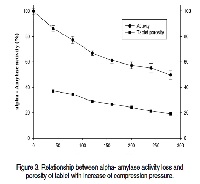Compressibility studies of đα- Amylase
Keywords:
amylase, microcrystalline cellulose, compressibility, percolation thresholdAbstract
Background: Proteins possess greater biochemical and structural complexity compared to conventional drug based pharmaceuticals. In the present study, we investigated the effect of compression force on the tablet properties, primarily the enzyme activity and the percolation threshold to have more information of behaviour of đ- Amylase powder under compaction along with detection of mixture range in which enzyme is protected by the excipients. Results: The results showed that carrageenan, tragacanth and agar provided the maximum protection to enzyme activity compared to microcrystalline cellulose and dicalcium phosphate dihydrate on compaction. However stability studies indicated the highest loss of enzyme activity with carrageenan, tragacanth and agar. The compressibility studies of different binary mixtures of đ- Amylase with microcrystalline cellulose indicated that đ- Amylase behaves like a brittle substance. The application of percolation theory on the relationship between the critical density as a function of enzyme activity and mixture composition revealed the presence of percolation threshold for binary mixture. đ- Amylase ă microcrystalline cellulose mixture composition showed significant percolation threshold at 37.23 % (w / w) đ- Amylase loading. Conclusion: Microcrystalline cellulose provided higher protection during stability study. However, higher concentrations of microcrystalline cellulose, probably as dominant particles do not protect the enzyme with their plastic deformation. Below the percolation threshold i.e. 37.23 % (w / w) đ- Amylase amount in mixture with plastic excipient, activity loss increases strongly because of higher shearing forces during compaction due to system dominance of plastic particles. This mixture range should therefore be avoided to get robust formulation.
References
Semalty A, Semalty M, Singh R, Saraf SK, Shubhini S. Properties and formulation of oral drug delivery system of protein and peptides. Ind J Pharm Sci. 2007; 69: 741–747.
Frokjaer S, Hovgaard L, Weert MVD. Formulation, stability and characterization of protein and peptide drugs. In: Mahato RI, editor. Biomaterials for delivery and targeting of proteins and nucleic acids, CRC Press, New York, 2005. p. 377–400.
Manning MC, Patel K, Borchardt RT. Stability of protein pharmaceuticals. Pharm Res. 1989; 6 (11): 903–918.
Leuenberger H, Rohera BD, Haas C. Percolation theory––a novel approach to solid dosage form design. Int J Pharm. 1987; 38: 109–115.
Blattner D, Kolb M, Leuenberger H. Percolation theory and compactibility of binary powder systems. Pharm Res. 1990; 7: 113–117.
Leuenberger H. The application of percolation theory in powder technology. Adv Powder Technol. 1999; 10: 323–352.
Layer P, Holtmann G. Pancreatic enzymes in chronic pancreatitis. Int J Pancreatol. 1994; 15: 1–11.
Jain S, Subramony C, Blanchard K, Petro M, Minocha A. Fibrosing colonopathy in a man with cystic fibrosis on pancreatic enzyme supplements. Ind J Gastroenterol. 2005; 24 (6): 238.
Takagi T, Toda H, Isemura T. Bacterial and mold amylases. In: Boyer PD, editor. The Enzymes, New York, Aademic Press, 1979, p. 235-271.
Thoma JA, Spradlin JE, Dygert S. Plant and animal amylases. In: Boyer PD, editor. The Enzymes, New York, Aademic Press, 1979, p. 115-189.
Groves MJ, Teng CD. The effect of compaction and moisture on some physical and biological properties of proteins. In: Ahern TJ, Manning MC, editors. Stability of Protein Pharmaceuticals, New York, Plenum Press, 1992, p. 311–359.
Zarrintan MH, Teng CD, Groves MJ. The effect of compactional pressure on a wheat germ lipase preparation. Pharm Res. 1990; 7: 247–250.
Wurster DE, Ternik RL. Pressure-induced activity loss in solid state catalase. J Pharm Sci. 1995; 84 (2): 190-194.
Bernfeld P, Colowick SP, Kalpan NO. Amylase α and β. Method Enzymol. 1962; 1: 149–158.
Heckel RW. An analysis of powder compaction phenomena. Trans Metall Soc AIME. 1961b; 221: 1001–1008.
Holman LE, Leuenberger H. The effect of varying the composition of binary powder mixtures and compacts on their properties: a percolation phenomenon. Powder Technol. 1990; 60: 249-258.
Travers DN, Merriman MPH. Temperature changes occurring during the compression and recompression of solids. J Pharm Pharmacol. 1970; 22: 11S-16S.
Wurster DE, Creekmore JR. Measurement of the thermal energy evolved upon tablet compression. Drug Dev Ind Pharm. 1986; 12: 1511-1528.
Heckel RW. Density – pressure relationship in powder compaction. Trans Metall Soc AIME. 1961a; 221: 671–675.
Morii M, Sano A, Takeguci N, Horokoshi I. Studies on inactivation of alkaline protease by tableting. Yakugaku Zasshi. 1973; 93: 300‐303.






